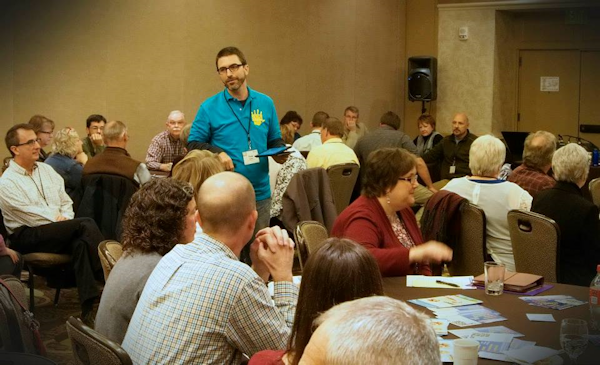Pastors and laity benefit from mentoring, networking and practical tools offered by the REACH Network.
ERIN F. WASINGER
REACH Network
When Matt Kreh began his two-point charge in Bath and Gunnisonville, he knew the 150-year-old churches needed to reach new people for Christ. He and his churches just weren’t sure where to start.
Enter the Reach Network group.
Reach Network groups follow the Reach Summit, a fall conference of speakers and workshops for those who want to transform their church. To avoid “post-conference syndrome” — that feeling of overwhelm after coming back from a motivating conference — the Reach Networks are meant to be practical, hands-on, year-long learning experiences in specific areas of ministry.
Kreh said he’s been personally and professionally empowered by the two years in a network group focusing on church systems.
That comes from the groups’ mentorship, networking, and practical tools, said Systems group leader Tom Arthur, pastor of Sycamore Creek Church in Lansing.
“When you’re struggling to be the kind of leader you feel called to, you have others right there with you.” ~ Tom Arthur
“When you’re struggling to be the kind of leader you feel called to, you have others right there with you,” Arthur said. “It’s pragmatic — you need a Reach Network group because it helps you be effective.”
Clergy, staff, and laity are encouraged to participate together. Laity participation creates a stronger enthusiasm for the mission. “When you went back to the church you had a shared vision and shared language,” Kreh said.
Need to transform
Reach network group co-leader Gary Step is pragmatic about the Reach groups.
Church members know they need to transform. “They know their options are limited in how much time you have left as a church,” said Step, director of Congregational Excellence for the Michigan Conference. Learning with others is crucial. Step’s group uses resources and speakers with their group to reinvigorate churches with declining membership — it’s to benefit not church members but people who haven’t stepped in the doors yet.
“I don’t think people realize how hard it is to reach a de-churched, unchurched person,” Step said. Launching one or two new services from his group of about ten churches is a success story, he said.
To increase a church’s odds, Step’s network uses a church-plant model to teach best practices for growth and multiplying disciples for Jesus. Topics include regaining the mission of the church and following Kingdom values, he said. Re-energizing the congregation and diagnosing a church as healthy are part of it, too. In 2017, Step will lead the group with as a self-paced, video-oriented series with coaches Ben Ingebretson and Cathy Townley.
Rev. Jon Reynolds from St. Paul’s found Step and Ingebretson’s network group integral to launching a second service at the Rochester church. More than 125 people attended St. Paul’s first preview service, he said. Beginning January 8, St. Paul’s will offer two 11 a.m. services in one building: one a traditional service and the other designed to reach new families.
“Even if you see no possibility of starting a new service in the next two calendar years, to yoke yourself to others” who are networking and inspired can inject life into stagnant plans, Reynolds said. Pastors might “think we have to have all our ducks in a row before we have to take our first step when in reality it can be easier than you realize when you’re not the only one taking it.”
That camaraderie is built through sharing experiences, struggles and ideas, said Bridget Nelson, coordinator of the Youth Worker Network. Books and speakers lead the content of each session. But relationships between youth ministry volunteers and staff continue past the discussion.
“While our clergy people have all kinds of meetings … people who work in local churches are pretty isolated in their building,” she said. And “someone else is trying to figure out the same things you are … that seemed to be the most valuable piece.”
Practical tools
Practical tools have been meaningful in Bath and Gunnisonville, Kreh said.
For example, one of Arthur’s sessions is on assimilation systems — working through questions like “In what ways is the church communicating with its members and guests?” and “How can churches connect with first-time guests if they don’t have guests’ names?”
One of Kreh’s churches used to pass a three-ring binder during service for people to mark their attendance. Now, his churches use a connection card born from the Reach group.
“(It’s about) constant, never-ending improvement over several years. You build that foundation and it slowly grows.” ~ Tom Arthur
Not one visitor gave pertinent information in the binder, he said. One of the significant changes is that Kreh now has “a pretty decent percentage” of guests coming for the first time giving his churches information about themselves on the connection card — and that allows him to follow up with them. “That’s made a huge difference.”
In 2017, seven streams will cover topics from engaging Hispanic communities to demographics to youth ministry. Reach Networks started in 2014; last year they drew more than 70 registrants from churches in mid Michigan. Registration for 2017 networks is now open at www.reachsummit.org.
Reach groups aren’t meant to be one-time, quick fixes. It’s about “constant, never-ending improvement over several years,” Arthur said. “You build that foundation and it slowly grows.”
~Erin F. Wasinger is a freelance writer in Lansing, Mich., and a partner at Sycamore Creek Church.
Last Updated on December 27, 2022

